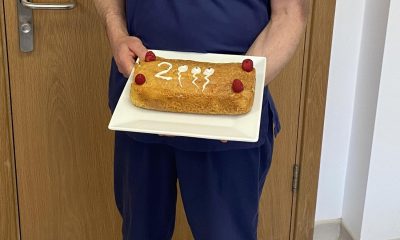By Georgia Lambert via SWNS
Next-generation artificial platelet particles have been developed to help stop people from bleeding to death after suffering traumatic injuries.
Biomedical researchers say that the synthetic blood cells could help save lives by rapidly stabilizing clots to reduce the amount of blood loss from injuries.
The new effort centered around the creation of the platelet-mimicking nanoparticles that help to generate a protein mesh that acts as a natural netting to stabilize blood clots and help stop bleeding.
Blood has four main components: plasma, red blood cells, white blood cells, and platelets.
These platelets help the blood-clotting process by quickly gathering at the site of an injury, sticking to the lining of the injured blood vessel, clustering to form a plug and amplifying the formation of fibrin - an insoluble protein mesh that slows bleeding.
Platelet transfusions are routinely used to prevent or treat cancer, bleeding complications in trauma, surgery, and various clotting disorders.
According to the American Red Cross, someone in the U.S. needs blood and or platelets every two seconds.
However, natural platelets aren’t always available or portable and they have a limited shelf life, which has prompted research over the last several decades to find synthetic alternatives.
So, if proven safe and efficient in clinical trials, the nano-technology would bolster the scientists’ advances in a decade-long effort to develop and optimize what they call synthetic platelet surrogates.
via GIPHY
Study leader Professor Anirban Sen Gupta, of Case Western Reserve University in the US, said: “This is the next step in artificial-platelet technology and it’s truly a critical advance.
“We have not only been able to form a plug to reduce bleeding from a traumatic injury, but to also help format fibrin, a protein mesh that secures the plug, further stabilizing the clot.”
Professor Sen Gupta and his team have, for the last decade, pioneered research in artificial platelet systems by working on therapeutic technologies with applications in hemostasis - the process of stopping bleeding.
They have also been working on ways to break harmful blood clots and by using a number of blood cell-related pathologies, they have worked on how to help inflammation.
In this research, the team reported that the nanoparticles - which the scientists refer to as the “platelet-mimicking procoagulant nanoparticles (PPNs)” - helped the clot form faster and stop bleeding in animal models, even when the body was drained of its natural platelets.
These promising results suggest that this new nanoparticle design could further enhance the performance of artificial platelet technologies that Professor Sen Gupta and his research team have been working hard to develop.
Prof Sen Gupta went on to explain that his team’s first-generation design has proven to mimic two functions of natural platelets.
The first is a type of “homing” mechanism that helps platelets sense and then stick to a bleeding injury.
While the second type is the ability of platelets to pile up on each other to form a plug, like stacking sandbags as a barrier that stops a flood—in this case bleeding.
He said: “But to ensure that the sandbags stay put under the force of the flood, you would need netting to secure them and then peg the netting down so it wouldn’t move.
“Fibrin is this netting, and we have shown that the PPNs can amplify formation of fibrin even when natural platelets are depleted.”
This research has suggested that PPNs could be used as a viable platelet surrogate to stop bleeding when natural platelet transfusion products are limited.
The study was published in the Science Translational Medicine journal.


 Parenting1 week ago
Parenting1 week ago
 Lifestyle6 days ago
Lifestyle6 days ago
 Good News3 days ago
Good News3 days ago
 Health3 days ago
Health3 days ago
 Wildlife2 days ago
Wildlife2 days ago
 Broadcast1 week ago
Broadcast1 week ago
 Environment1 week ago
Environment1 week ago
 Work1 day ago
Work1 day ago





















